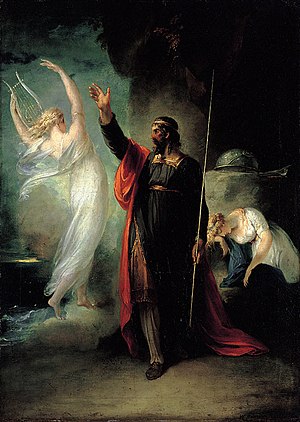Sylph: Difference between revisions
From AnthroWiki
No edit summary |
No edit summary |
||
| Line 1: | Line 1: | ||
[[File:William Hamilton Prospero and Ariel.jpg|thumb|Ariel and Prospero in [[w:Shakespeare|Shakespeare]]'s ''[[w:The Tempest|The Tempest]]'']] | [[File:William Hamilton Prospero and Ariel.jpg|thumb|Ariel and Prospero in [[w:Shakespeare|Shakespeare]]'s ''[[w:The Tempest|The Tempest]]'']] | ||
The '''sylphs''', '''air spirits'''<ref name=ghosts>The designation -''ghosts''' is strictly speaking not correct, since they do not have an independent [[I]], thus no [[individual]]s [[spirit]].</ref> or '''elementary beings of the air''' weave and work in the | The '''sylphs''', '''air spirits'''<ref name=ghosts>The designation -''ghosts''' is strictly speaking not correct, since they do not have an independent [[I]], thus no [[individual]]s [[spirit]].</ref> or '''elementary beings of the air''' weave and work in the [[air]]y-[[warmth|warm]], interspersed with [[light]], in the movements of the clouds and the wind, from the finest breeze to the mighty storm. They also include various elves and the gigantic [[storm spirit]]s. Their best-known representatives in poetry are the air spirit Ariel, who appears in [[w:Shakespeare|Shakespeare]]'s [[w:The Tempest|The Tempest]] and also appears in [[w:Johann Wolfgang von Goethe|Johann Wolfgang von Goethe]]'s Faust, as well as the elf king [[w:Oberon|Oberon]] and the elf queen [[w:Titania (A Midsummer Night's Dream)|Titania]] from [[w:A Midsummer Night's Dream|A Midsummer Night's Dream]]. | ||
==Literature== | ==Literature== | ||
Revision as of 15:41, 22 September 2021

The sylphs, air spirits[1] or elementary beings of the air weave and work in the airy-warm, interspersed with light, in the movements of the clouds and the wind, from the finest breeze to the mighty storm. They also include various elves and the gigantic storm spirits. Their best-known representatives in poetry are the air spirit Ariel, who appears in Shakespeare's The Tempest and also appears in Johann Wolfgang von Goethe's Faust, as well as the elf king Oberon and the elf queen Titania from A Midsummer Night's Dream.
Literature
- Flensburger Hefte 79 Was die Naturgeister uns sagen - Im Interview direkt befragt ISBN 3-935679-09-2
- Flensburger Hefte 80 Neue Gespräche mit den Naturgeistern ISBN 3-935679-10-6
- FH-Sonderheft Nr. 21 Naturgeister 3 - Von Rauch-, Wiesen-, Torf- und Maschinenwesen ISBN 3-935679-17-3
- FH-Sonderheft Nr. 22 Naturgeister 4 - Fragenkompendium ISBN 3-935679-18-1
- Rudolf Steiner: Natur- und Geistwesen – ihr Wirken in unserer sichtbaren Welt, GA 98 (1996), ISBN 3-7274-0980-0 English: rsarchive.org German: pdf pdf(2) html mobi epub archive.org
- Rudolf Steiner: Die geistigen Wesenheiten in den Himmelskörpern und Naturreichen, GA 136 (1996), ISBN 3-7274-1361-1 English: rsarchive.org German: pdf pdf(2) html mobi epub archive.org
- Rudolf Steiner: Das Sonnenmysterium und das Mysterium von Tod und Auferstehung, GA 211 (1986) English: rsarchive.org German: pdf pdf(2) html mobi epub archive.org
- Rudolf Steiner: Der Mensch als Zusammenklang des schaffenden, bildenden und gestaltenden Weltenwortes, GA 230 (1985) English: rsarchive.org German: pdf pdf(2) html mobi epub archive.org
- Rudolf Steiner: Zur Geschichte und aus den Inhalten der erkenntniskultischen Abteilung der Esoterischen Schule von 1904 bis 1914, GA 265 (1987), ISBN 3-7274-2650-0 English: rsarchive.org German: pdf pdf(2) html mobi epub archive.org
 |
References to the work of Rudolf Steiner follow Rudolf Steiner's Collected Works (CW or GA), Rudolf Steiner Verlag, Dornach/Switzerland, unless otherwise stated.
Email: verlag@steinerverlag.com URL: www.steinerverlag.com. Index to the Complete Works of Rudolf Steiner - Aelzina Books A complete list by Volume Number and a full list of known English translations you may also find at Rudolf Steiner's Collected Works Rudolf Steiner Archive - The largest online collection of Rudolf Steiner's books, lectures and articles in English. Rudolf Steiner Audio - Recorded and Read by Dale Brunsvold steinerbooks.org - Anthroposophic Press Inc. (USA) Rudolf Steiner Handbook - Christian Karl's proven standard work for orientation in Rudolf Steiner's Collected Works for free download as PDF. |
References
- ↑ The designation -ghosts' is strictly speaking not correct, since they do not have an independent I, thus no individuals spirit.
